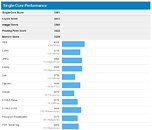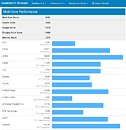Raevenlord
News Editor
- Joined
- Aug 12, 2016
- Messages
- 3,755 (1.16/day)
- Location
- Portugal
| System Name | The Ryzening |
|---|---|
| Processor | AMD Ryzen 9 5900X |
| Motherboard | MSI X570 MAG TOMAHAWK |
| Cooling | Lian Li Galahad 360mm AIO |
| Memory | 32 GB G.Skill Trident Z F4-3733 (4x 8 GB) |
| Video Card(s) | Gigabyte RTX 3070 Ti |
| Storage | Boot: Transcend MTE220S 2TB, Kintson A2000 1TB, Seagate Firewolf Pro 14 TB |
| Display(s) | Acer Nitro VG270UP (1440p 144 Hz IPS) |
| Case | Lian Li O11DX Dynamic White |
| Audio Device(s) | iFi Audio Zen DAC |
| Power Supply | Seasonic Focus+ 750 W |
| Mouse | Cooler Master Masterkeys Lite L |
| Keyboard | Cooler Master Masterkeys Lite L |
| Software | Windows 10 x64 |
A Geekbench page has just surfaced for AMD's upcoming Raven Ridge APUs, which bring both Vega graphics and Ryzen CPU cores to AMD's old "the future is Fusion" mantra. The APU in question is being tagged as AMD's Raven Ridge-based Ryzen 5 2500U, which leverages 4 Zen cores and 8 threads (via SMT) running at 2.0 GHz with AMD's Vega graphics.
According to Geekbench, the Ryzen APU scores 3,561 points in the single-core score, and 9,421 points in the multi-core score. Compared to AMD's A12-9800, which also leverages 4 cores (albeit being limited to 4 threads) running at almost double the frequency of this Ryzen 5 2500U (3.8 GHz vs the Ryzen's 2 GHz), that's 36% better single-core performance and 48% better multi-core performance. These results are really fantastic, and just show how much AMD has managed to improve their CPU (and in this case, APU) design over their Bulldozer-based iterations.






View at TechPowerUp Main Site
According to Geekbench, the Ryzen APU scores 3,561 points in the single-core score, and 9,421 points in the multi-core score. Compared to AMD's A12-9800, which also leverages 4 cores (albeit being limited to 4 threads) running at almost double the frequency of this Ryzen 5 2500U (3.8 GHz vs the Ryzen's 2 GHz), that's 36% better single-core performance and 48% better multi-core performance. These results are really fantastic, and just show how much AMD has managed to improve their CPU (and in this case, APU) design over their Bulldozer-based iterations.






View at TechPowerUp Main Site
Last edited:


